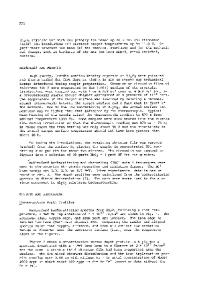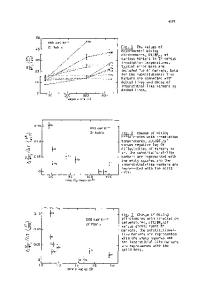Energy Dependence of Compound Growth in Au-Al and Cu-Al Bilayer Systems During Ion Beam Mixing
- PDF / 280,078 Bytes
- 6 Pages / 420.48 x 639 pts Page_size
- 96 Downloads / 307 Views
ENERGY DEPENDENCE OF COMPOUND DURING ION BEAM MIXING
GROWTH IN Au-Al AND Cu-Al BILAYER SYSTEMS
S.U.CAMPISANO,CHU-TECHANG ,S.CANNAVO' AND E.RIMINI Istituto Dipartimentale di Fisica, UniversitA di Catania, Corso Italia 57, 195129, Catania,Italy
ABSTRACT The kineticsof phase formation and growth in Au-Al and Cu-Al thin film bilayers under ion beam bombardment was investigated in detail for the dependence on the beam energy. The experimental data can be interpreted within the radiation enhanced diffusion description, taking into proper account the target configuration, the growth of a new phase and the deposited energy density distribution.
INTRODUCTION Ion beam induced phase formation has been studied in a few thin film bilayer systems 11,21. In the case of the Au-Al system 131 the two compounds, Au2Al and AuAI 2 , are formed in the sequence Au-Au 2 AI-AuAl 2 -Al. The thickness of these phases increases linearly with the square root of the fluence and the growth rate depends on the beam energy and layer thickness combination. In the Cu-Al system only the AI 4 Cu9 phase has been detected and the growth kinetics occurs with similar trend. A linear relationship between thickness and (dose)2 suggests a diffusion like process in which atom migration can occur in both directionsalong the beam incidence. A "modified" radiation enhanced diffusion description 141 can explain the experimental data in both systems. EXPERIMENTAL Au and Al thin layers were evaporated sequentially onto glass substrates, maintained at -30'C to avoid the formation of thin layezsof Au 5 Al2. The asevaporated samples were stored at LN 2 temperature for the same reason. Du7 ring the evaporation the residual pressure was less than 3xlO- Torr. Typical thicknesses were 150-220 nm and 40-80 nm for Au and Al, respectively. The Cu-Al bilayers were made by the same process. The samples were irradiated 1 2 at LN 2 temperature with Kr ions for doses of 10 -2xlO16/cm in the energy range 60-240 keV. The power density of the beam was maintained below 0.1 Watt. A thin film thermocouple 151 was used to measure the temperature during implantation and the maximum temperature was less than lOOK. 2 MeV He+ backscattering and X-ray diffraction techniques were adopted to measure the thickness and to identify the formed phases respectively. Experimental details are reported elsewhere 131. RESULTS The irradiation of a 200 nm thick Au and 75 nm thick Al bilayer with 6 2 140 keV Kr ions to a fluence of 2xlO /cm causes the formation of Au 2 Al and
SPermanent tist
Mat. Res.
address: Shanghai Institute of Nuclear Research. Visiting scien on the basis of INFN - Academia Sinica cultural exchange plan.
Soc. Symp. Proc. Vol.
27 (1984) @Elsevier science Publishing Co., Inc.
98
~~ b idKr/cm' -Au
J
0 U$ -_A,,,2,
•ýý
a)
A
06
1.4
1.0
1.8
ENERGY(MeV)
Fig.f, 2 Mey He+ backscattering spectra for Au-Al sample implanted with
2x1O Kr/cm plantation.
at 140 keV.
The dashed line refers to the sample before im-
Au
Al
200 keVKr
20XkeVKr
200
100-
iz
0
0 Kr 140OkeV
Data Loading...











